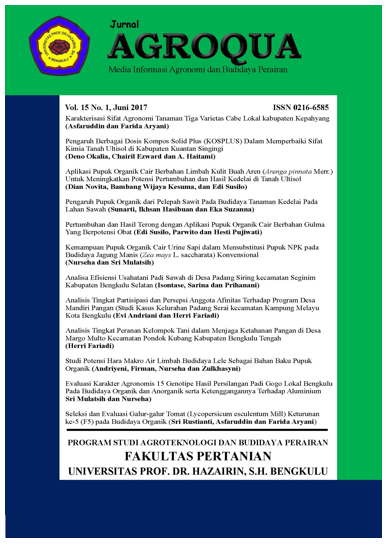KAJIAN KECUKUPAN HARA FOSFOR PADA LAHAN SULFAT MASAM POTENSIAL TERHADAP PERTUMBUHAN DAN PRODUKSI BEBERAPA VARIETAS KEDELAI
DOI:
https://doi.org/10.32663/ja.v19i1.1534Keywords:
Phosphorus, potential acid sulfate land, soybeanAbstract
The development of acid sulfate land for agricultural land faces many obstacles, including high soil acidity and low P nutrient availability due to fixation by Al and Fe. Soil characteristics in the Langsa City area are classified as marginal soils with high soil acidity. But to ensure the successful management of acid sulfate into productive agricultural land must be managed properly. One effort can be done to ensure the successful management of acid sulfate land into productive land. This research was conducted in the acid sulfate field of Simpang Wie village, East Langsa Subdistrict, Langsa City, which was conducted in Mai until September 2019. This study aimed to determine the P dose of some soybean varieties in potential acid sulfate fields. This research used a factorial randomized block design (RBD) with 2 replications. The first factor is the soybean variety factor (V) which consists of 4 varieties namely V1 = Burangrang, V2 = Sibayak, V3 = Anjasmoro, and V4 = Willis and the second factor is the dose of Phosphorus fertilizer (P) which consists of 4 levels namely P1 = 0 kg P2O5, P2 = 36 kg P2O5, P3 = 72 kg P2O5 and P4 = 108 kg P2O5. Provision of Phosphorus nutrients in various soybean varieties significantly differ in plant height at ages 4 and 6 MST, number of productive branches at age 6 MST, number of pods per plant, the weight of 100 soybean seeds, and nutrient content of acid sulfate soils. The best phosphorus nutrient to increase the growth and yield of soybean plants in acid sulfate soils is 108 kg ha-1 P2O5. Willis soybean varieties are more responsive to the supply of Phosphate nutrients in acid sulfate soils which are characterized by the best growth and yield of soybeans compared to other varieties.
References
Downloads
Published
Issue
Section
License
Authors who publish with this journal agree to the following terms:
- Authors grant the journal right of first publication with the work simultaneously licensed under a Creative Commons Attribution 4.0 Internasional (CC BY 4.0) Licence that allows others to use and share the work with an acknowledgment of the work's authorship and initial publication in this journal.
- The author(s) still hold the copyright of his/her/their work and retain publishing rights without restrictions such as (but not limited to) patent right, lecture, book and reproduce the article for own purposes.
















